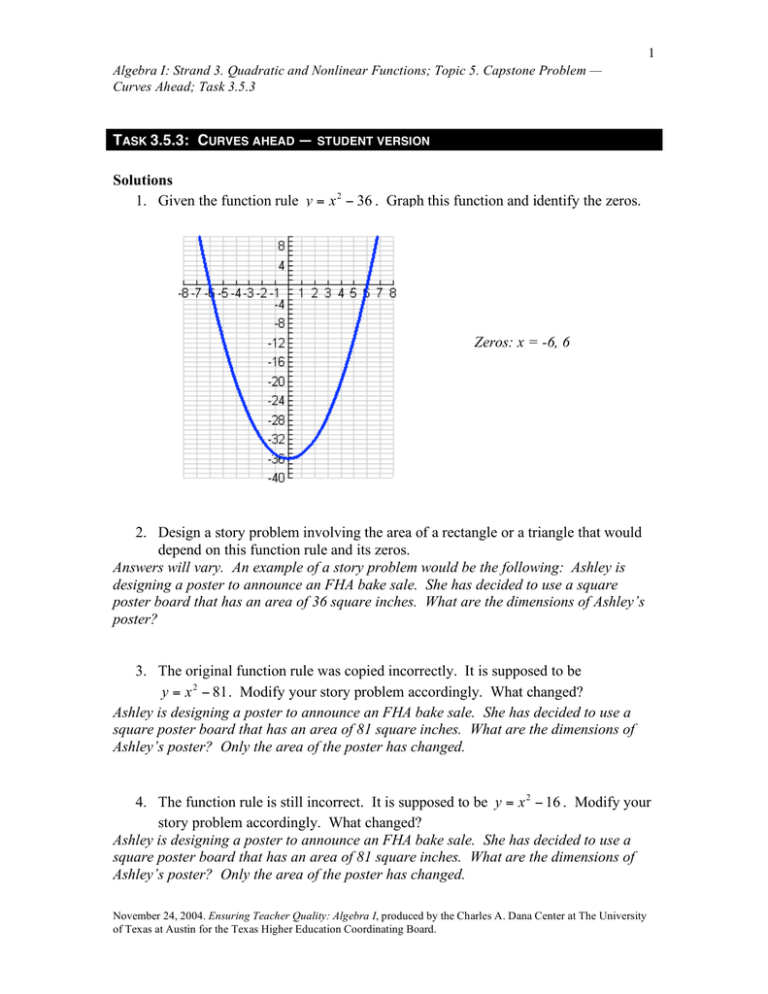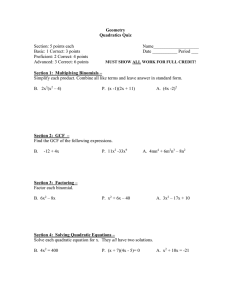Document 11665343
advertisement

1 Algebra I: Strand 3. Quadratic and Nonlinear Functions; Topic 5. Capstone Problem — Curves Ahead; Task 3.5.3 TASK 3.5.3: CURVES AHEAD — STUDENT VERSION Solutions 1. Given the function rule y = x 2 ! 36 . Graph this function and identify the zeros. Zeros: x = -6, 6 2. Design a story problem involving the area of a rectangle or a triangle that would depend on this function rule and its zeros. Answers will vary. An example of a story problem would be the following: Ashley is designing a poster to announce an FHA bake sale. She has decided to use a square poster board that has an area of 36 square inches. What are the dimensions of Ashley’s poster? 3. The original function rule was copied incorrectly. It is supposed to be y = x 2 ! 81 . Modify your story problem accordingly. What changed? Ashley is designing a poster to announce an FHA bake sale. She has decided to use a square poster board that has an area of 81 square inches. What are the dimensions of Ashley’s poster? Only the area of the poster has changed. 4. The function rule is still incorrect. It is supposed to be y = x 2 ! 16 . Modify your story problem accordingly. What changed? Ashley is designing a poster to announce an FHA bake sale. She has decided to use a square poster board that has an area of 81 square inches. What are the dimensions of Ashley’s poster? Only the area of the poster has changed. November 24, 2004. Ensuring Teacher Quality: Algebra I, produced by the Charles A. Dana Center at The University of Texas at Austin for the Texas Higher Education Coordinating Board. 2 Algebra I: Strand 3. Quadratic and Nonlinear Functions; Topic 5. Capstone Problem — Curves Ahead; Task 3.5.3 5. Graph the three functions on the same coordinate plane. What do you notice about the graphs? Include vertices and y-intercepts and relate them to the functions. The graphs have the same shape shifted up or down. The “skinniness” of the three parabolas is the same. The y-intercepts and the vertices occur at the same point, (0, c) where c is the constant value in each function. 6. In general, if you are given the form y = x 2 + c , how does the value of c affect the graph? The y-intercept of the graph will occur at the point (0, c) and the y-axis is the line of symmetry. Thus c will determine the placement of the graph vertically. 7. Suppose the original function is changed once again. This time the function changes from y = x 2 ! 36 to y = 4 x 2 " 36 . Modify your story problem accordingly. Ashley is designing a poster to announce an FHA bake sale. She has decided to use a poster board whose length is 4 times the width. If the poster board has an area of 36 square inches, what are the!dimensions of Ashley’s poster? 8. Suppose the original function is changed for a final time. This time the function changes to y = 9x 2 ! 36 . Modify your story problem accordingly. Ashley is designing a poster to announce an FHA bake sale. She has decided to use a poster board whose length is 9 times the width. If the poster board has an area of 36 square inches, what are the dimensions of Ashley’s poster? November 24, 2004. Ensuring Teacher Quality: Algebra I, produced by the Charles A. Dana Center at The University of Texas at Austin for the Texas Higher Education Coordinating Board. 3 Algebra I: Strand 3. Quadratic and Nonlinear Functions; Topic 5. Capstone Problem — Curves Ahead; Task 3.5.3 9. Graph the last two functions on the same coordinate plane with the original. What do you notice about the graphs? Include the vertices and y-intercepts and relate them to the function. These function rules all have the same vertex (0, 36), which is also the y-intercept for each graph. The parabolas though are getting skinnier as the a in y=ax2+c is getting larger (where a>1). This means that for each x, the corresponding y-value associated with graph (8) is larger than the corresponding y-value of graph (7) which is larger than the y-value of graph (1). 10. In general, if you are given the form y = ax 2 + c , where a >0, how does the value of a affect the graph? The value of a determines the “skinniness” or “fattiness” of the graph. 11. In these exercises, you were asked to use the area of a rectangle or triangle to create a story problem involving a quadratic equation and its solutions. Determine as many different geometric shapes that you can that might be used in a story problem of this type. Explain how each is related to quadratics. Solutions may include any of these examples (or lots of others): o Area of a square o Area of a circle o Area of a triangle o Hypotenuse of a right triangle o Area of a parallelogram o Volume of a cylinder with constant height o Volume of a rectangular box with length of one dimension constant November 24, 2004. Ensuring Teacher Quality: Algebra I, produced by the Charles A. Dana Center at The University of Texas at Austin for the Texas Higher Education Coordinating Board. 4 Algebra I: Strand 3. Quadratic and Nonlinear Functions; Topic 5. Capstone Problem — Curves Ahead; Task 3.5.3 TASK 3.5.3: CURVES AHEAD — STUDENT VERSION 1. Given the function y = x 2 ! 36 . Graph this function and identify the zeros. 2. Design a story problem involving the area of a rectangle or a triangle that would depend on this function and its zeros. 3. The original function was copied incorrectly. It is supposed to be y = x 2 ! 81 . Modify your story problem accordingly. What changed? November 24, 2004. Ensuring Teacher Quality: Algebra I, produced by the Charles A. Dana Center at The University of Texas at Austin for the Texas Higher Education Coordinating Board. 5 Algebra I: Strand 3. Quadratic and Nonlinear Functions; Topic 5. Capstone Problem — Curves Ahead; Task 3.5.3 4. The function is still incorrect. It is supposed to be y = x 2 ! 16 . Modify your story problem accordingly. What changed? 5. Graph the three functions on the same coordinate plane. What do you notice about the graphs? Include vertices and y-intercepts and relate them to the function. 6. In general, if you are given the form y = x 2 + c , how does the value of c affect the graph? 7. Suppose the original function is changed once again. This time the function changes from y = x 2 ! 36 to y = 4x 2 ! 36 . Modify your story problem accordingly. November 24, 2004. Ensuring Teacher Quality: Algebra I, produced by the Charles A. Dana Center at The University of Texas at Austin for the Texas Higher Education Coordinating Board. 6 Algebra I: Strand 3. Quadratic and Nonlinear Functions; Topic 5. Capstone Problem — Curves Ahead; Task 3.5.3 8. Suppose the original function is changed for a final time. This time the function changes to y = 9x 2 ! 36 . Modify your story problem accordingly. 9. Graph the last two functions on the same coordinate plane with the original. What do you notice about the graphs? Include the vertices and y-intercepts and relate them to the function. 10. In general, if you are given the form y = ax 2 + c , where a >0, how does the value of a affect the graph? 11. In these exercises, you were asked to use the area of a rectangle or triangle to create a story problem involving a quadratic equation and its solutions. Determine as many different geometric shapes that you can that might be used in a story problem of this type. Explain how each is related to quadratics. November 24, 2004. Ensuring Teacher Quality: Algebra I, produced by the Charles A. Dana Center at The University of Texas at Austin for the Texas Higher Education Coordinating Board.



